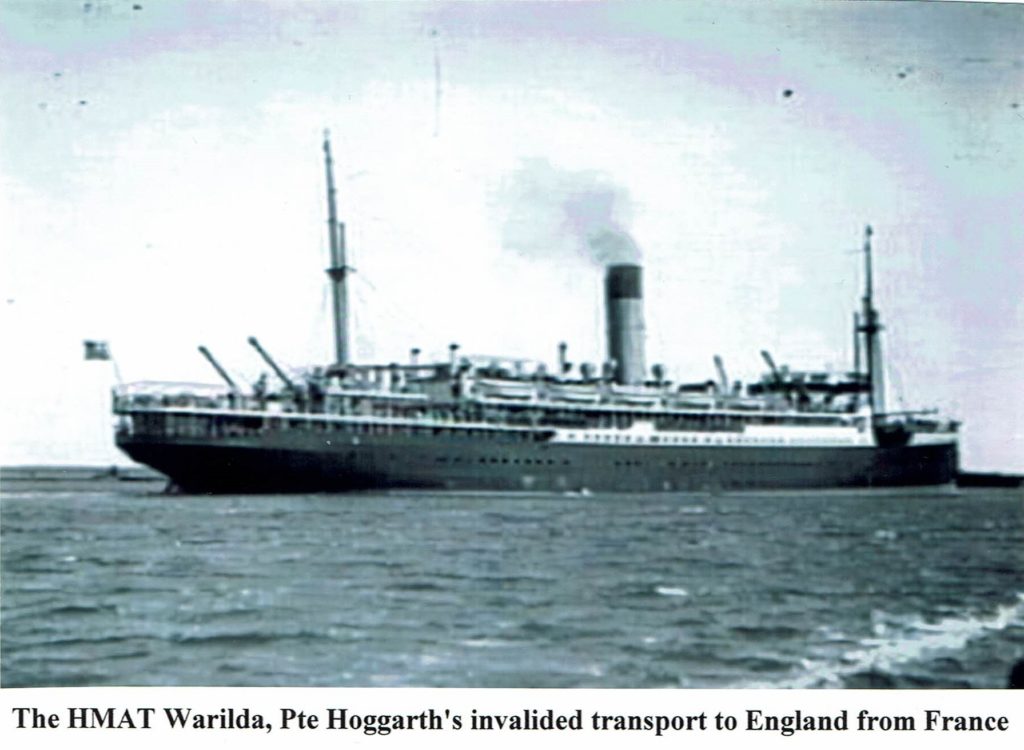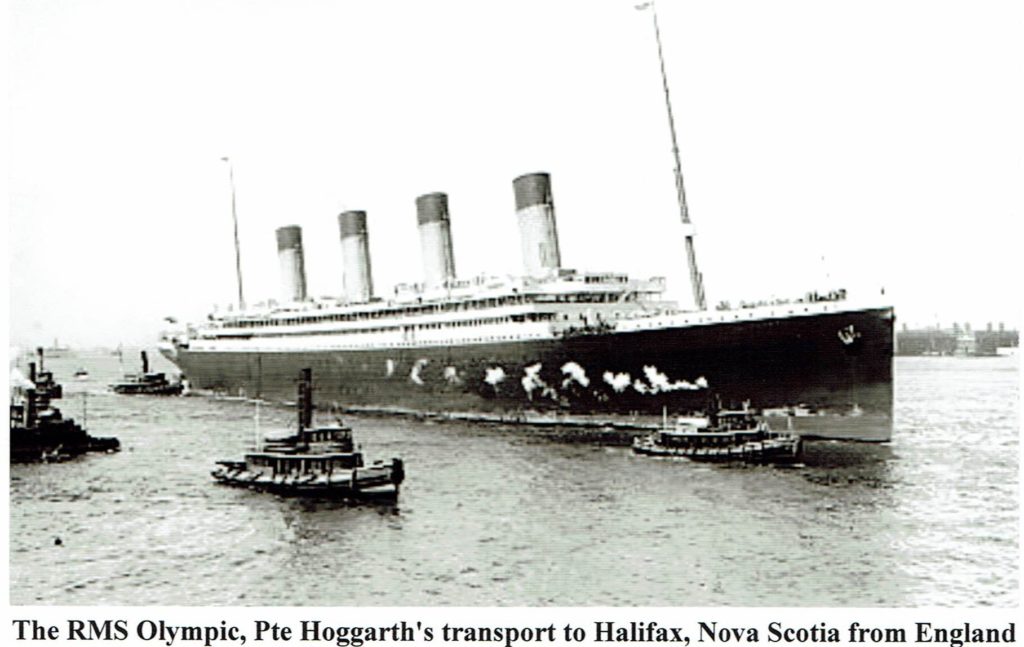MILITARY HISTORY
Private George Douglas Hoggarth — Service Number 49030 — ACTIVE SERVICE (World War I)
George Douglas Hoggarth, was a 22 years, 11 months and 13 days old when, as a single man he enlisted with the 1st Canadian Remount Depot* on September 25, 1914 in Valcartier, Québec with the Canadian Army, Canadian Expeditionary Force (CEF) Overseas. He was living in Curve Lake Ontario at the time and gave his birth date as October 12, 1891, born in Peebles, Scotland. George Douglas indicated that he had served in the Scots & Greys Service for 18 months. His previous employment is listed as a Lineman. George Douglas was 5′ 8″ tall, 39½” chest, dark-brown hair and grey eyes and weighed 156 pounds; he had an “arch” shaped tattoo on his left forearm. George Douglas named his mother, Mrs. John Hoggarth, as his next-of-kin at 8 St. Michaels Building, Peebles Scotland. George Douglas had his Medical done on September 1, 1914 in Valcartier, Québec; he was considered fit for CEF (Overseas) duty. He entered as a Private (Pte) with Service Number 49030 and was assigned to the 1st Canadian Remount Depot (CRD).
* The 1st Canadian Remount Depot, a Unit of the 1st Canadian Army Veterinary Corps, was responsible for the training of horses and mules for the Canadian Army. The 1st Canadian Remount Depot was organized at Valcartier, Québec in September 1914 and was composed of the 100th , 101st , and 102nd Remount Squadrons. It arrived in France on May 16, 1915 and was situated at Hautot, France.
On September 30, 1914 Pte Hoggarth was taken-on-strength with the 1st CRD at Valcartier, Québec and was promoted to Corporal (Cpl). December 23, 1914 Pte Hoggarth forfeits 2-day’s pay for being absent without Leave. On February 26, 1915 Cpl Hoggarth reverts to the Ranks on request at Westdown South and was absent and forfeited 5-day’s pay. April 10, 1915, at Amesbury, he paid $10.36 for extra clothing. On May 10, 1915 Pte Hoggarth embarked from Canada to England; although not stated in his File, he would have disembarked at England about May 21, 1915. December 18, 1915 Pte Hoggarth is still on-strength of the 1st Remount Depot, Canadian Section, 3rd Echelon, British Expeditionary Force (BEF).
March 14, 1916 in France, Pte Hoggarth was charged with “not complying with an order given by a Non-Commissioned Officer (NCO)”. He was assessed 5 days Confined to Barracks (CB). April 10, 1916 Pte Hoggarth was struck-off-strength from the 1st CRD on transfer to the 1st Canadian Veterinary Hospital (CVH), Dieppe, France. April 11, 1916 he was taken-on-strength with the 1st CVH in the Field. December 24, 1916 Pte Hoggarth was granted 12 days Leave in the UK. January 4, 1917 he returned to the Field from Leave.
September 11, 1917 Pte Hoggarth was admitted to No 2 General Hospital at Le Havre, France; he reported sick; complaining of a back-ache, head-ache and swelling in his face. He was diagnosed with Albuminuria# and on September 15, 1917 Tpr Hoggarth was invalided in the Field to the 1st CVH and sent to England on His Majesty’s Australian Transport (HMAT) Warilda and posted to the General Depot at Shorncliffe. On September 16, 1917 he was admitted to the 1st South General Hospital Monyhull at Birmingham, England with a diagnosis of Albumin and was prescribed 4 weeks bed rest, a milk diet and hot air baths. Also on September 16, 1917 Tpr Hoggarth was taken-on-strength to the General Depot from the 1st CVH at Shorncliffe, England.
October 30, 1917 Tpr Hoggarth is transferred to the Canadian Convalescent Hospital at Woodcote Park, Epsom, England with a diagnosis of Albumin. November 8, 1917 he is admitted to the Canadian Military Hospital; King’s Red Cross Convalescent Hospital at Buchey Park, England with a diagnosis of Nephritis#. Tpr Hoggarth was discharged January 30, 1918. February 6, 1918 Tpr Hoggarth is struck-off-strength from the 1st General Depot at Shorncliffe, England. November 27, 1918 Pte Hoggarth has a Dental check-up; the procedure found that his dental condition was “unfit”. Although he had decay of teeth which was attributed to Active Service, he refused treatment. December 7, 1918 Tpr Hoggarth is struck-off-strength from the General Depot to the CEF Canada at Witley, England and embarked for Canada aboard the HMS Olympic. Pte Hoggarth disembarked at Halifax, Nova Scotia on December 14, 1918.
December 17, 1918 Pte Hoggarth is taken-on-strength from the CEF (Overseas) to Casualty Company, No 3 District Depot for disposal at Kingston, Ontario and was granted Disembarkation Leave to January 3, 1919. January 9, 1919 Pte Hoggarth received his last pay, including a $35.00 Clothing Allowance; the sum total was $568.32. January 10, 1919 Pte Hoggarth was struck-off-strength from the Canadian Army (Active) on discharge due to demobilization. His Discharge Certificate was signed on January 10, 1919 at Kingston, Ontario. George Douglas Hoggarth’s address on discharge was The Montreal House, Peterborough Ontario.
# Nephritis is inflammation of the kidneys. Also called Bright’s disease.
Albuminuria is the presence of Albumin in urine, typically as a symptom of kidney disease. Albumin is a simple form of protein that is soluble in water and coagulable by heat.
Note: George Douglas Hoggarth is Andrew Abraham Hogarth’s father. George Douglas Hoggarth’s File has him as a Private and a Trooper without any explanations.
There is no reference, in Private George Douglas Hoggarth’s Military File indicating what Military Medals he was awarded but based on his Military Service, he should have received:
British War Medal 1914 – 1920; and
Victory Medal.
He also qualified for War Service Badge CEF Class “A”.
Based on his Military File, Private George Douglas Hoggarth served a total of 4 years, 3 months, and 16 days with the Canadian Expeditionary Force: 8 months and 12 days in Canada; 2 years, 2 months and 5 days in England; 1 years, 5 months, 4 days in France and 20 days travel time.
George Douglas Hoggarth died May 1, 1961.
An excerpt from an article in Maclean’s Magazine by Barbara Ameil, September 1996:
”The Military is the single calling in the world with job specifications that include a commitment to die for your country. What could be more honourable”?
PERSONAL HISTORY
GEORGE DOUGLAS HOGGARTH
George Douglas Hoggarth was born in Peebles, a royal burgh in Tweeddale near Edinburgh, Scotland on October 12, 1891, the son of Mr. and Mrs. John Hoggarth. He immigrated to Canada in 1912, first coming to Toronto and then to Lakefield where he worked on the building of the Canada Cement factory. George Douglas went by the nickname “Scotty”.
Worthy of note is that George Douglas, spelled his name with “two gs” and that some of his children, including Andrew, either by intent or error, adapted to the one “g”. Hence the family continues to evolve with both spellings.
On September 25, 1914 he enlisted in Valcartier, Québec as a Private with the 1st Canadian Remount Depot, Canadian Expeditionary Force (Over-Seas). George returned home in June of 1919 and settled in Curve Lake, Ontario. George, 29, married Hannah “Louise” Taylor, 18; daughter of Abraham and Nellie Taylor, a First Nations native of the Curve Lake Reservation. George and Louise had a family of nine children: Andrew “Andy” Abraham; Harold Douglas; Jean; George (Jr); Charles; John “Jack”; Donald; Pearl; Helen Louise and Clifford.
Around 1921, the family moved to Burleigh Falls and George worked for the Trent-Severn Canal System. He eventually became lockmaster at Lovesick Lake and Burleigh Falls until his retirement. At both Canal locations, the family lived in the lockmaster’s house provided as a job benefit by the Trent-Severn Canal System.
George Douglas Hoggarth died on May 1, 1961 and is buried in the Curve Lake Cemetery.
THE GEORGE DOUGLAS HOGGARTH FAMILY OF CURVE LAKE, ONTARIO
George Douglas’ parents, John Hoggarth and Mrs. John Hoggarth were born and married in Scotland.


